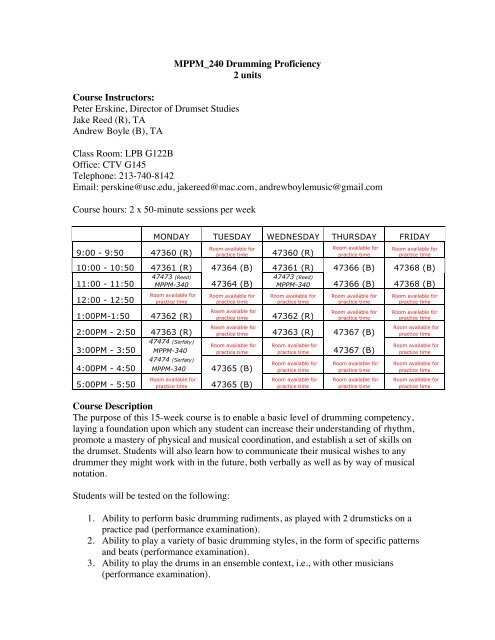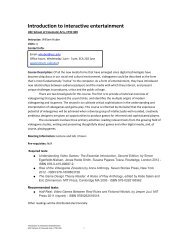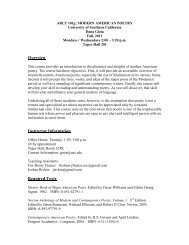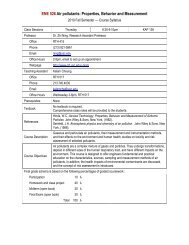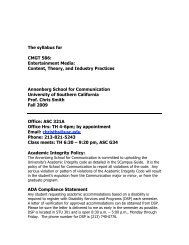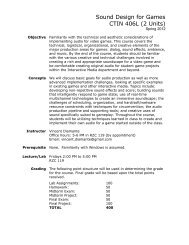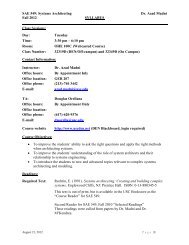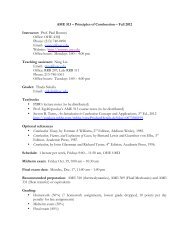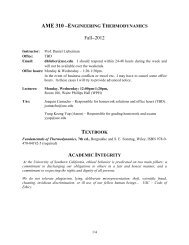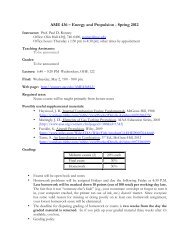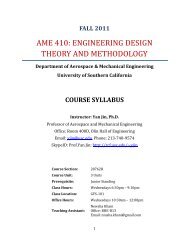MPPM-240 Syllabus Autumn 2012 - USC Web Services
MPPM-240 Syllabus Autumn 2012 - USC Web Services
MPPM-240 Syllabus Autumn 2012 - USC Web Services
You also want an ePaper? Increase the reach of your titles
YUMPU automatically turns print PDFs into web optimized ePapers that Google loves.
Course Instructors:<br />
Peter Erskine, Director of Drumset Studies<br />
Jake Reed (R), TA<br />
Andrew Boyle (B), TA<br />
<strong>MPPM</strong>_<strong>240</strong> Drumming Proficiency<br />
2 units<br />
Class Room: LPB G122B<br />
Office: CTV G145<br />
Telephone: 213-740-8142<br />
Email: perskine@usc.edu, jakereed@mac.com, andrewboylemusic@gmail.com<br />
Course hours: 2 x 50-minute sessions per week<br />
9:00 - 9:50 47360 (R)<br />
MONDAY TUESDAY WEDNESDAY THURSDAY FRIDAY<br />
Room available for<br />
practice time<br />
47360 (R)<br />
Room available for<br />
practice time<br />
Room available for<br />
practice time<br />
10:00 - 10:50 47361 (R) 47364 (B) 47361 (R) 47366 (B) 47368 (B)<br />
11:00 - 11:50<br />
12:00 - 12:50<br />
47473 (Reed)<br />
<strong>MPPM</strong>-340 47364 (B)<br />
Room available for<br />
practice time<br />
1:00PM-1:50 47362 (R)<br />
2:00PM - 2:50 47363 (R)<br />
3:00PM - 3:50<br />
4:00PM - 4:50<br />
5:00PM - 5:50<br />
Room available for<br />
practice time<br />
Room available for<br />
practice time<br />
47474 (Serfaty)<br />
<strong>MPPM</strong>-340<br />
47474 (Serfaty)<br />
Room available for<br />
practice time<br />
<strong>MPPM</strong>-340 47365 (B)<br />
Room available for<br />
practice time<br />
47473 (Reed)<br />
<strong>MPPM</strong>-340 47366 (B) 47368 (B)<br />
Room available for<br />
practice time<br />
47362 (R)<br />
Room available for<br />
practice time<br />
Room available for<br />
practice time<br />
Room available for<br />
practice time 47363 (R) 47367 (B)<br />
47365 (B)<br />
Room available for<br />
practice time<br />
Room available for<br />
practice time<br />
Room available for<br />
practice time<br />
47367 (B)<br />
Room available for<br />
practice time<br />
Room available for<br />
practice time<br />
Room available for<br />
practice time<br />
Room available for<br />
practice time<br />
Room available for<br />
practice time<br />
Room available for<br />
practice time<br />
Room available for<br />
practice time<br />
Room available for<br />
practice time<br />
Course Description<br />
The purpose of this 15-week course is to enable a basic level of drumming competency,<br />
laying a foundation upon which any student can increase their understanding of rhythm,<br />
promote a mastery of physical and musical coordination, and establish a set of skills on<br />
the drumset. Students will also learn how to communicate their musical wishes to any<br />
drummer they might work with in the future, both verbally as well as by way of musical<br />
notation.<br />
Students will be tested on the following:<br />
1. Ability to perform basic drumming rudiments, as played with 2 drumsticks on a<br />
practice pad (performance examination).<br />
2. Ability to play a variety of basic drumming styles, in the form of specific patterns<br />
and beats (performance examination).<br />
3. Ability to play the drums in an ensemble context, i.e., with other musicians<br />
(performance examination).
4. An understanding of the role and development of the drumset in contemporary<br />
music (aural and written examination).<br />
Course Materials — MANDATORY<br />
1 pr. Drumsticks for practice pad studies (Vic Firth SD1)<br />
1 pr. Drumsticks for drumset playing (Vic Firth “Peter Erskine Big Band” Stick)<br />
“Drumset Essentials, Vol. 1” by Peter Erskine (Alfred Publishing)<br />
“Time Awareness for All Musicians” by Peter Erskine (Alfred Publishing)<br />
All of these items, i.e., sticks & books, are available from amazon.com, etc.<br />
The class/course will provide drumsets in the laboratory; kits to be Roland electronic pad<br />
kits with teacher-to-individual student communications by way of headsets similar to an<br />
electronic keyboard lab. USB “flash sticks” are recommended!<br />
Grading and Exams<br />
• Aural and Written Mid-term examination (25%) Examination of aural and<br />
written materials pertaining to drumming styles and history presented in the first 7<br />
weeks of class.<br />
• Drumming Skills Exam #1 (25%) Students must demonstrate a mastery of basic<br />
drumming skills on the practice pad as well as drumset “time” playing, i.e., beats<br />
that involve the steadiness of tempo and a measure of drumbeat competency.<br />
• Final Exam/Drumming Skills Exam #2 (50%) All students will perform in a<br />
jury type of setting for the Instructor. They may be asked to play basic drum<br />
rudiments on the practice pad, as well as a beat in any of the styles, tempos that<br />
have been studied throughout the semester on the drumset. Drumset chart reading<br />
will also be part of the final examination.<br />
Attendance<br />
Attendance is expected for all classes. Attendance for examinations is mandatory.<br />
Please review Final Exam schedule in the Schedule of classes to avoid potential conflicts.<br />
Because of the amount of material to covered each semester, it is necessary to impose the<br />
following attendance policy:<br />
Classes that meet once a can allow one unexcused absence. Each additional unexcused<br />
absence will result in a half grade deduction. Classes that meet twice a week (i.e., the<br />
single 50-minute class) can allow two unexcused absences. Each additional unexcused<br />
absence will result in a half grade deduction. Being more than ten minutes tardy will<br />
count as an absence! BE ON TIME.<br />
Statement for Students with Disabilities<br />
Any student requesting academic accommodations based on a disability is required to<br />
register with Disability <strong>Services</strong> and Programs (DSP) each semester. A letter of<br />
verification for approved accommodations can be obtained from DSP. Please be sure the<br />
letter is delivered to me (or to TA) as early in the semester as possible. DSP is located in
STU 301 and is open 8:30 a.m.–5:00 p.m., Monday through Friday. The phone number<br />
for DSP is (213) 740-0776.<br />
Statement on Academic Integrity<br />
<strong>USC</strong> seeks to maintain an optimal learning environment. General principles of academic<br />
honesty include the concept of respect for the intellectual property of others, the<br />
expectation that individual work will be submitted unless otherwise allowed by an<br />
instructor, and the obligations both to protect one’s own academic work from misuse by<br />
others as well as to avoid using another’s work as one’s own. All students are expected to<br />
understand and abide by these principles. Scampus, the Student Guidebook, contains the<br />
Student Conduct Code in Section 11.00, while the recommended sanctions are located in<br />
Appendix A: http://www.usc.edu/dept/publications/SCAMPUS/gov/. Students will be<br />
referred to the Office of Student Judicial Affairs and Community Standards for further<br />
review, should there be any suspicion of academic dishonesty. The Review process can<br />
be found at: http://www.usc.edu/student-affairs/SJACS/.<br />
Summary of class structure<br />
(all descriptions below predicated on the assumption that most students will be righthanded;<br />
students will be asked to swap “right” to “left” instructions if they are lefthanded;<br />
a kit can be set-up to accommodate left-hand students [it should be noted that the<br />
choice for a left-hander to set-up and play the kit in reverse is optional and not always<br />
practiced by some leading professional/left-handed players]; the other option is for the<br />
left-handed student to play on a “right-handed” kit utilizing an “open” grip, i.e., the left<br />
hand will play the lead rhythms on the hi-hat, etc., while the right hand plays the snare<br />
backbeat, etc.)<br />
Week 1<br />
Basic Drumming Techniques<br />
1. Grip (of sticks)<br />
2. Physical relationship to the pad, snare drum and drumset (promoting efficiency as<br />
well as safe drumming habits).<br />
3. Alternating hand rhythms, with an emphasis on proper technique utilizing a<br />
proper combination of arm, wrist and finger involvement and movement.<br />
SUMMARY: Intro to class: overview presented by Professor Erskine; how V-drums<br />
work, purchase books and pad<br />
Basic techniques (grip, physical relationship to pad/drums, proper stroke technique-arm,<br />
wrist, finger); Eight on a Hand, single stroke roll, 8-7-6-5-4-3-2-1-2-3-4-5-6-7-8 warmup<br />
and coordination exercise<br />
Week 2<br />
1. Review of basic grip principles and technique.<br />
2. Basic drumming rudiments (handouts as provided by the lecturer)<br />
3. An explanation and exploration of the rhythmic subdivisions that make up basic<br />
drum beats and styles; students will be taught to appreciate and give full value to<br />
the spaces between the beats.
4. Assignment: p. 29 1-6, read pp. 1-25 in D.S. Essentials<br />
5. Listening: “Billie Jean”<br />
6. Doubles, Paradiddles<br />
SUMMARY (Week 2): Review Basic techniques, Basic Rudiments (single stroke, double<br />
stroke, paradiddle), Explain/explore subdivisions—the exact mathematical distribution of<br />
sound or silence in a given beat, measure, or phrase of music, appreciate and give full<br />
value to spaces b/n notes…whole notes to 32 nd notes. Learn by rote basic D.S. Essentials<br />
beat e.g. “Billie Jean”<br />
Week 3<br />
Basic Drumbeats 1<br />
1. Straight-8 th beats and 4-limb coordination (rock/pop style)<br />
2. Students will work on a series of beat variations as laid out in “Drumset<br />
Essentials, Vol. 1”<br />
3. Students will have access to “play-along” CD tracks by way of the book/CD<br />
package “Drumset Essentials, Vol. 1” (Basic Beats in Drumset Essentials, playalong)<br />
4. Permutations of 16 th note groupings<br />
5. Hand out: 16 th note variations—3 note variations<br />
6. Rudiments: multiple bounce, double bounce “diddles”, 5 stroke roll, flam, drag<br />
7. Assignment: pp. 28-31 1-10, emphasize 4 bar phrasing, use simple 2 beat fills<br />
8. Listening: groove-“Wait For Tomorrow” by Jimi Hendrix (#6 on p. 28), fill-“Give<br />
Me One Reason” by Tracy Chapman (“Pat Boone Debbie Boone” 2 beat fill)<br />
Week 4<br />
Basic Drumbeats 2<br />
1. Students are taught how to play the jazz “ride” pattern<br />
a. ride cymbal technique<br />
b. ride cymbal pattern phrasing, i.e., swing feel.<br />
2. Basic left hand independence/coordination while right hand plays swing beat.<br />
3. 16 th note variations—2 note variations<br />
4. Exercise: accents w/ 16 th notes<br />
5. Listening: “Freddie Freeloader” (brief explanation of 12 bar blues) and “Jimmy<br />
Cobb” beat.<br />
Week 5<br />
A short history of the evolution of the drumset and drumming styles<br />
1. Development of the drumset as we know it today<br />
2. Important drummers in the history of contemporary music, vis-à-vis a study of<br />
jazz and popular music history<br />
3. How the blues form has been used in various styles. History of bass drum pedal.<br />
4. Listening assignments, plus a handout (history); students will be advised of an<br />
upcoming written test and aural exam.<br />
Week 6<br />
1. LABORATORY PLAYING OF ALL MATERIAL TO DATE.
2. Review of aural and written materials pertaining to drumming styles and history.<br />
Week 7<br />
1. Aural and Written Mid Term examination; this exam’s results will comprise 25%<br />
of the student’s final grade.<br />
2. DRUMMING SKILLS EXAM #1 (2 nd hour)<br />
Students must demonstrate a mastery of basic drumming skills on the practice pad<br />
as well as drumset “time” playing, i.e., beats that involve the steadiness of tempo<br />
and a measure of drumbeat competency.<br />
This exam’s results will comprise 25% of the student’s final grade.<br />
3. Assignment for next week: read Time Awareness<br />
Week 8<br />
1. Quarter-notes in BD while reading rhythms on SD<br />
2. 16ths w/ accents—Quarters in BD—2 bar patterns—accents on toms<br />
3. Polyrhythms and hemiola (p. 38 in Time Awareness)<br />
Play-Along performances in class by all students (to strengthen confidence and ability to<br />
play “in front of others”).<br />
Week 9<br />
1. Funk and Pop Rhythms w/ BD quarters (Time Awareness p. 35)<br />
2. Advanced drum grooves pt. 2<br />
3. Rudiment: single stroke four and application on d.s.<br />
4. Advanced drum grooves pt. 1: “Chameleon”, paradiddle groove, opening HH,<br />
accents on HH<br />
5. Fills with syncopation: e.g. Phil Collins fill, Raphael Saadiq more contemporary<br />
usage<br />
6. Ted Reed book (p. 33, 38)<br />
Week 10<br />
1. Write 4 grooves using 8 th notes in HH<br />
2. Compose grooves w/ 8 th in HH, 16 th note variations with BD integration to<br />
improve facility—use these ideas as fills, etc.<br />
Week 11<br />
1. Drum Fills<br />
How to connect one musical phrase to the next by means of improvising rhythms<br />
on the drumset that are variations of, or different from, the beats that have been<br />
taught to date.<br />
(Students will be provided with written examples to practice, all the while being<br />
encouraged to exercise their own creative and motor skills by coming up with<br />
their own “fills.”
2. In-class performance of 1 beat written by students, work on “four on floor”<br />
coordination, write solo using 16 th ideas (possibly taken from “Syncopation” hand<br />
out from week 9)<br />
3. Listening: “The End” by The Beatles<br />
4. Compose 8 measure solo using “four on the floor”<br />
Week 12<br />
The study of written drumset parts<br />
1. How to read a basic drumset part<br />
2. How to write a basic drumset part<br />
3. Slash notation vs. Rhythmic notation<br />
The Percussive Art Society standard of drumset notation (i.e., which part of the<br />
kit is notated on which line or space of the musical stave) will be presented and<br />
studied. Handouts will be provided.<br />
4. Work on/perform solos, chart reading<br />
5. Listening: “Since I’ve Been Loving You” by Led Zeppelin<br />
Week 13<br />
1. The drumset in contemporary musical applications.<br />
2. Solo w/ “four on floor”, Family Fun(k), brushes, other types of grooves (eg.<br />
include use of flams, non-backbeat grooves)<br />
3. Listening: “Clocks” by Coldplay<br />
Week 14<br />
1. Listening quiz<br />
2. TAs will provide help in preparation for FINAL exam<br />
Week 15<br />
Final Exam and Course Evaluations<br />
Final Exam / DRUMMING SKILLS EXAM #2<br />
All students will perform in a jury type of setting for the Instructor. They may be asked to<br />
play basic drum rudiments on the practice pad, as well as a beat in any of the styles,<br />
tempos that have been studied throughout the semester on the drumset.<br />
This exam’s results will comprise 50% of the student’s final grade.<br />
IN ADDITION: PROFESSOR ERSKINE WILL PROVIDE IN-CLASS LECTURES AS<br />
WELL AS OUTSIDE-OF-CLASSROOM WORKSHOPS:<br />
Acoustic Drums + cymbals<br />
1. Laboratory playing of acoustic drumset (versus lab electronic kit); every student<br />
will have the opportunity and obligation to play on a “real” drumset in front of the<br />
class. Students may be accompanied by the Instructor, or an actual rhythm<br />
section.<br />
2. The basics of BRUSH PLAYING will be demonstrated. Jazz and popular music<br />
styles using brushes will be covered, and long-term practice methods will be
demonstrated. RhythmTech “LapTop” pads will be distributed for brush-playing<br />
experience during these sessions.<br />
Practicing: All students are expected to practice for at least TWO HOURS per week<br />
during the course. The Class Schedule at the beginning of this syllabus shows the<br />
available practice time LPB G122B during <strong>USC</strong> daytime class hours. Please note that<br />
your <strong>USC</strong> ID card will allow you access to the room at all other hours of the night or day,<br />
24-7. The best way to get better is to play. Have fun, and welcome to drumming!<br />
For your convenience, here is the Section schedule with available practice times, etc.<br />
9:00 - 9:50 47360 (R)<br />
MONDAY TUESDAY WEDNESDAY THURSDAY FRIDAY<br />
Room available for<br />
practice time<br />
47360 (R)<br />
Room available for<br />
practice time<br />
Room available for<br />
practice time<br />
10:00 - 10:50 47361 (R) 47364 (B) 47361 (R) 47366 (B) 47368 (B)<br />
11:00 - 11:50<br />
12:00 - 12:50<br />
47473 (Reed)<br />
<strong>MPPM</strong>-340 47364 (B)<br />
Room available for<br />
practice time<br />
1:00PM-1:50 47362 (R)<br />
2:00PM - 2:50 47363 (R)<br />
3:00PM - 3:50<br />
4:00PM - 4:50<br />
5:00PM - 5:50<br />
Room available for<br />
practice time<br />
Room available for<br />
practice time<br />
47474 (Serfaty)<br />
<strong>MPPM</strong>-340<br />
47474 (Serfaty)<br />
Room available for<br />
practice time<br />
<strong>MPPM</strong>-340 47365 (B)<br />
Room available for<br />
practice time<br />
47473 (Reed)<br />
<strong>MPPM</strong>-340 47366 (B) 47368 (B)<br />
Room available for<br />
practice time<br />
47362 (R)<br />
Room available for<br />
practice time<br />
Room available for<br />
practice time<br />
Room available for<br />
practice time 47363 (R) 47367 (B)<br />
47365 (B)<br />
Room available for<br />
practice time<br />
Room available for<br />
practice time<br />
Room available for<br />
practice time<br />
47367 (B)<br />
Room available for<br />
practice time<br />
Room available for<br />
practice time<br />
Room available for<br />
practice time<br />
Room available for<br />
practice time<br />
Room available for<br />
practice time<br />
Room available for<br />
practice time<br />
Room available for<br />
practice time<br />
Room available for<br />
practice time


